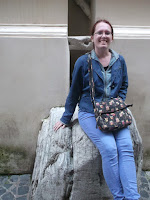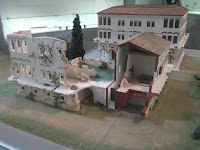It is a lot easier to create a show for Sarmatians than it is for Gepids. Go figure. This Germanic ethnic group did not leave written sources of their own behind - all we know about them, we know from chronicles written by others about the Gepids. Out of these historical accounts emerges the sad tale of Rosamund, a Gepid princess kidnapped and abused by Alboin, king of the Langobards, arch-enemies of her people, who was forced to drink from the skull of her own father. She ended up having her husband assassinated, and then got executed herself - her story still lives in ballads in Lombardy.
Well, this is kind of a mood-killer, but a very important part of early medieval European history. I was lucky enough to dig up a frame story that made it amazing: Theophylact Simocatta, Byzantine historian, recorded a murder case where the suspect (a Gepid mercenary) used this tale in his defense. The mystery case, together with the tale of the Gepid-Langobard feud, ended up being a pretty neat historical story, if I do say so myself. The rest of the program I filled up with legends about my old friend Dietrich, who is a legendary figure based on Theodoric the Great, king of the Ostrogoths, who were not exactly friendly with the Gepids, but they were related, and Gepid warriors did serve in Theodoric's army. I also threw some Germanic/Norse mythology into the mix, and some German folktales for little children, in case we got any.
(We didn't)
Since last year I told in a full Sarmatian costume, I decided to keep to this tradition as well. My Gepid outfit just kind of happened - it was assembled from gifts I got over the past years from my SCA friends, all of which just happened to fit perfectly into a reconstruction of a famous Gepid female burial that my former archaeology professor published. All I really needed to buy was some beads to recreate the necklace and belt ornaments, and I was ready to roll!
There were two one-hour shows scheduled for the day, both of which were promoted to school groups since they happened during a school day. In the first round I had a 5th grade class (20-something students), accompanied by some adults. They were a loud bunch of little smartasses, and I absolutely loved them. They had comments for everything, but they were comments related to the tales, and moved the plot forward in hilarious ways. I opened with the tale of the Gepid warrior's trial, then moved on to Dietrich legends - the tale of Mighty Huntress Lady Minne, Sigenot the Giant, Sistram Who Was Fished Out of the Mouth of a Dragon, and finally, just for good measure, the myth of Thor and Utgard-Loki. After this last one they wanted to know if I could also tell a story about Deadpool (I wish), or Iron Man (to which I pointed out that everyone was wearing iron in all these stories). Generally the mood was great, I had fun with the cheeky comments, and the stories felt awesome in the telling. None of them (except for the first one) was too serious, and they hit the age group just right.
Some of the gems:
Me: "King Dietwart and Lady Minne lived happily ever after."
Boy: "Did they have children?"
Me: "Actually, they did! According to the chronicles, they had forty-four children."
Boy: "Whaaaat! How do you name that many children?"
Me: "You don't. You number them."
Boy: "But how? Did she have one child a day?"
Girl: "Stupid! You can't have a child in a day!"
Boy: "Why not?"
Me: "After they pulled Sistram out of the dragon's mouth, they needed to make sure the story was always remembered."
Boy: "So they took a selfie!"
Me: "Well, there were no cameras back then, but they did a medieval selfie."
Boy: "They painted a picture?"
Me: "That's right! Onto Sistram's shield!"
Boy: "That's awesome."
Me: [Telling about Thor losing all of Utgard-Loki's challenges]
Boy: "I BET THEY ARE ALL CHEATING!"
Me: [Tell them what they really were]
Boy: "I TOLD YOU"
And my favorite:
Girl: "How old are you?"
Me: "Thirty."
Girl: "Oooooh."
Me: "I have been a storyteller for ten years!"
Boy: "Compared to that, you are really good!"
And my favorite:
Girl: "How old are you?"
Me: "Thirty."
Girl: "Oooooh."
Me: "I have been a storyteller for ten years!"
Boy: "Compared to that, you are really good!"
The school group for the second round did not show, but I still got a lovely audience: Two mothers with their kids (one with a girl and one with a boy), and several of the museum's archaeologists. I did the same lineup again, except this time I told a short version of King Laurin's Rose Garden instead of the Norse myth. Sistram flew even better the second time around, and there was a lot of laughter in the audience. The best moment was when the little boy (maybe 6 or 7) literally said a line of the story the same time I said it (it was "This is not worth starting a war over").
All in all, I had a wonderful time. I loved being in costume, I enjoyed all the stories, and the audience made it all absolutely worthwhile. I am already slated to appear again next year. I wonder what the theme will be... I need to get sewing.

















